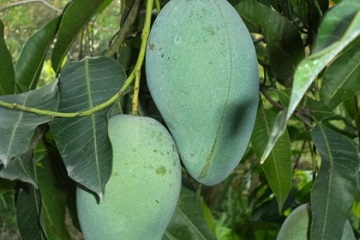A Group of Researchers of IPB Developed Post-harvest Heat Treatment To Maintain Quality of Mango

Mangoes are juicy stone fruit (drupe) from numerous species of tropical trees belonging to the flowering plant genus Mangifera, cultivated mostly for their edible fruit. Mangoes (Mangifera indica L.) include agriculture products that are susceptible to damage and shrinkage. Mangoes are highly pressure- and impact-sensitive and appropriate care must therefore be taken during cargo handling. The cold chain must at all costs be maintained, since the cargo will otherwise spoil rapidly. In damp weather (rain, snow), the cargo must be protected from moisture, as there is otherwise a risk of premature spoilage. Postharvest handling using cold temperatures can maintain shelf life and reduce shrinkage. However, storage using low temperatures can cause chilling injury and decrease the quality of mangoes. Chilling injury (CI) is characterized by black / brown spots on the skin of the fruit, incomplete color formation and abnormal maturation.
The mango handling and ripening protocol is designed to help improve mango handling practices, leading to better quality mangos, greater consumer acceptance and higher mango sales. Therefore a group of researchers of the Department of Mechanical Engineering and Biosystem, Faculty of Agricultural Technology, Bogor Agricultural University (IPB), namely Gysberth Pattiruhu, Y. Aris Purwanto, and Emmy Darmawanty from implemented the research program to investigate the effects of low storage temperatures on storage life and quality of mango gadung during storage at.
Fruit quality is an important factor in influencing consumer preferences in international and domestic markets. CA storage seems to be promising in extending storage life, maintaining quality of mango fruit consequently offers opportunities to export mangoes to distant markets using sea freight. Cold storage is intended to lower the product temperature so that it can slow the rate of respiration. Theoretically, the lower the storage temperature, the respiration ability of fresh fruits can be further inhibited. Because at low storage temperatures, solubidity of fluid in fruit cells will be higher that can suppress the process of respiration products, "said Aris Purwanto.
But according to cold storage with improper temperatures can cause chilling injury and contributes to decline in product quality and will affect the sale value.
" The effects of a postharvest heat treatment on aspects of ripening and development of handling of mangoes has been used to modify stress-affected products under optimum temperature and maintain fruit quality during storage," he said.
According to Aris, post-harvest handling of heat can be done only a few minutes at 40-60 ° C with hot water treatment or it can be done by warming the temperature within hours or days at a temperature of 20-40 ° C called intermittent warming. This handling is intended to reduce the level of cold damage.
The results of this study show that giving hot water treatment (HWT) for 3 minutes can reduce the occurrence of cold damage and maintain the quality and chemical content of mango. While intermittent warming (IW) treatment after 2 days or 3 days in this study was not effective in reducing cold damage and maintaining the quality of mango during storage at low temperatures. It was concluded that in order to extend the shelf-life and marketing period of mango, the fruit should be stored at 12ºC and 90-95%RH, because the fruit will not suffer from chilling injury and will undergo normal ripening process. (Wied)



